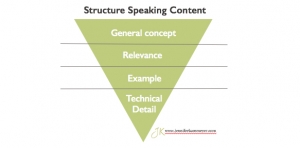Ideate, Structure, Communicate
Adding the step of structuring your content after you create it and before you communicate it makes it much easier for the audience to understand and boosts your confidence, increasing the effectiveness of an interaction.
Most of us learned the five-paragraph essay in school. When we are writing an academic paper or article we know to first preview what we are going to tell people. Then we share each point starting with a header sentence and give proof through concepts, numbers, and examples. After sharing our ideas, we know to summarize in a closing paragraph. But not many of us are taught to speak that way.
Often, we speak whatever comes to mind, in the order it comes to mind. We may start with one interesting detail and then another unrelated detail and then tie the two together in a relevant concept. Or we may just share a stream of data and let the listeners connect the dots.
Because the brain assimilates information better when it knows what is coming, structuring our communication first is much more effective. In education we call it ‘anticipatory set.’ Think of the process as creating buckets for the brain so it knows where to put the information it receives.
I was recently coaching a young professional who caught on to this structuring-before-communicating concept very quickly and demonstrated it well while giving a speech to a few hundred people. Instead of jumping into the details of a slide, this professional first described what the audience was seeing and contextualized the information. I could actually see the audience following along closely and nodding their heads as they assimilated the relatively complex information shared.
Including the preparation of structuring content between ideate and communicate is even more important when on video conference because the higher level of distraction inhibits focus. The audience has distractions in their own environment and also on screen. The more you guide their focus the more effective the communication. The implicit nature of structure (preview, signaling, summary) is a means for guiding their focus.
We already know how to do structure in writing, and it works well there. It makes complete sense to do it while speaking. It is just a matter of preparing a bit in advance. That preparation can be done far in advance for really important interactions and in the moment every day.
30-Second Prep– Pause for half a minute to formulate your thoughts and articulate what overarching concept you want to express.
2-Minute Prep– Before a meeting, scratch on a piece of paper or capture notes on your phone the key points you want to share and the theme that ties them all together.
1-hour Prep– Prepare talking points before a meeting or delivering a presentation that begin with the overarching concept, specify key points, and then give details on each key point.
Try one of these content structuring preparation options this week and see how it changes how you speak and how your audience reacts. The advance structuring has the benefit of the audience better assimilating the information you are sharing and the bonus of increasing your confidence. Both improve the communication interaction.
